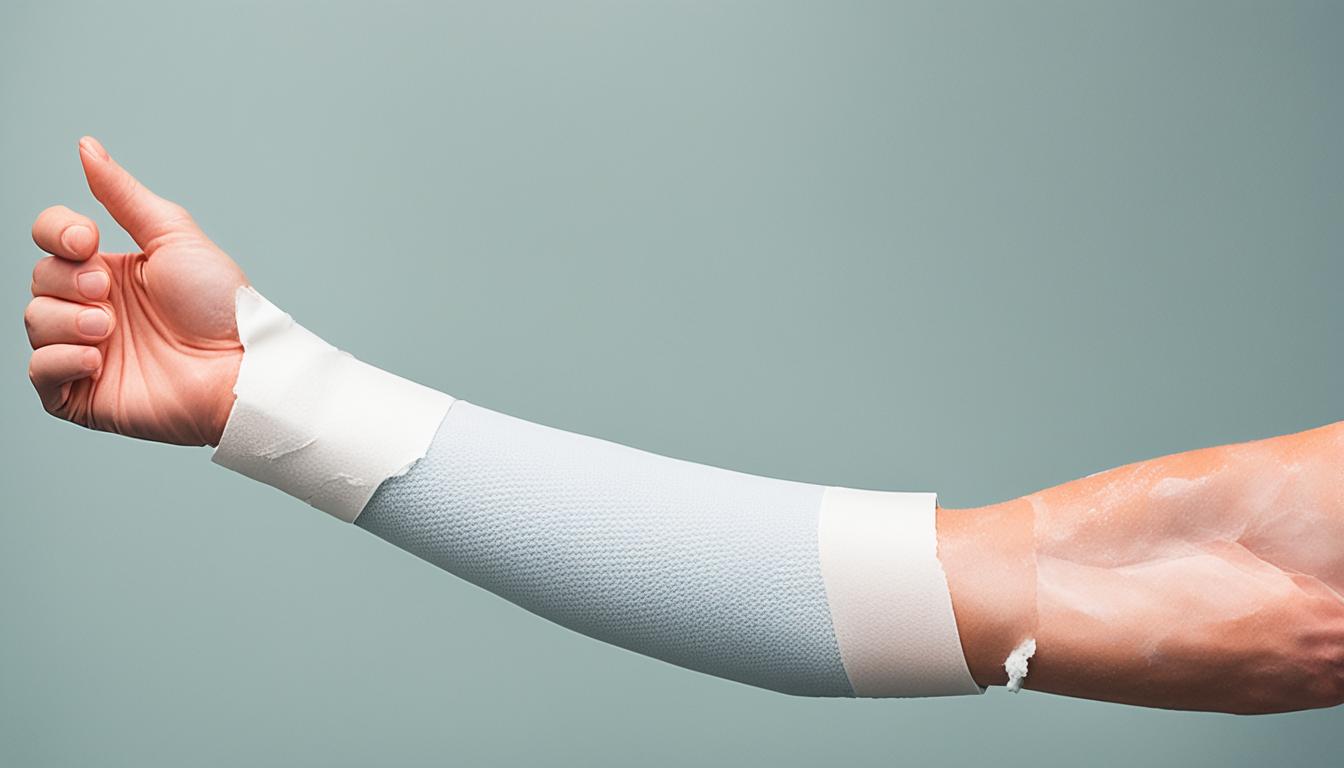A broken arm is a crack or break in a bone. It happens when there’s a strong force or stress on the bone. Anybody can get it, and it can occur in any bone. There are different kinds of fractures, like closed fractures that don’t hurt the skin, compound fractures that do, and more.
If you have a broken arm, you might feel pain, see swelling, or have bruised skin. You could even feel like your arm looks different or can’t move it well. A doctor finds a fracture with a checkup and special pictures like X-rays. To fix it, you may need surgery or a cast to hold your bones in place. Recovery can take a while, from weeks to months, depending on how bad it is.
Key Takeaways:
- Bone fractures, commonly known as broken arms, can be caused by high force impact or stress.
- Symptoms of a broken arm include pain, swelling, bruising, discolored skin, and deformity.
- Diagnosis involves physical examination and imaging tests such as X-rays, MRI, or CT scans.
- Treatment options include bone realignment, immobilization with casts or braces, surgical intervention, and physical therapy.
- Healing time varies depending on the severity of the injury and overall health, typically taking several weeks to several months to heal.
Causes and Risk Factors for Broken Arm
Broken arms happen due to different causes and risk factors. Knowing these can help people prevent such injuries. This knowledge guides them in making choices for their health.
Physical Trauma
Physical trauma, from accidents, falls, or sports, often leads to broken arms. High-impact forces can break bones in the arm.
Overuse and Repetitive Actions
Repeating certain arm movements can also cause broken arms. Things like heavy lifting, throwing, or swinging stress the bones. This makes them more likely to break.
Osteoporosis
Osteoporosis leads to fragile and weak bones. Those with this condition are more prone to fractures, like in the arm. With age, the risk of broken arms due to osteoporosis increases.
Bone Cancer
Bone cancer weakens the bones, increasing the risk of arm fractures. Even a light hit might cause a fracture if someone has bone cancer.
Age
As people get older, their bones weaken and become more prone to breaking. Less bone strength due to aging means a higher risk of broken arms.
Diagnosis
Doctors diagnose broken arms by looking at how the injury happened. They also do a physical exam. Tests like X-rays, MRIs, or CT scans help confirm the break and its severity.
Spotting a sprain versus a break is tough, making exact diagnosis key. It ensures people get the right care and avoid further issues.
Coping with a broken arm is tough, but knowing its causes and risks is vital. This helps in preventing such incidents and seeking quick medical help.
Treatment and Complications of Broken Arm
Treating a broken arm helps the bone heal well for the best outcome. Doctors align the broken bones through a process called reduction. This step is key for the bone to start healing on its own. Depending on how bad the break is, this process could involve manual repositioning or surgery.
To hold the bones still while they heal, doctors can use casts or braces. Severe breaks might need surgery. Here, doctors use special tools like metal plates to keep the bones steady. After the healing is done, you might need physical therapy to get back your muscle strength and the ability to move the arm well.
Most broken arms get better with the right care. But, sometimes, there can be issues. These include bones not lining up correctly, bone growth problems, and even infections. To treat these problems, doctors may use different methods. These can include things like ultrasound, bone grafts, or stem cells.
Living a healthy life helps prevent breaks and promotes faster healing. A healthy diet, regular exercise, and avoiding smoking and too much alcohol are good steps. This way, you lower the chances of facing a broken arm in the first place.

